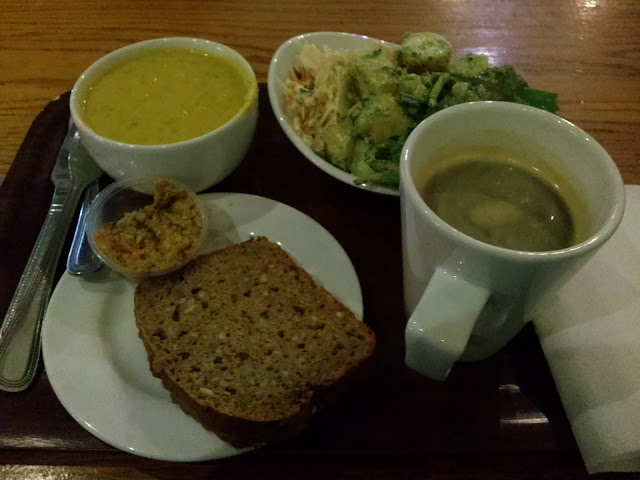Tämä postaus ei varsinaisesti liity niin vahvasti Australiaan tai australialaisiin, mutta päätin silti kirjoittaa pienen mielipidepostauksen suhtautumisesta ruokaa. Eräänä päivänä tässä vapaaehtoispaikan emäntämme koki ausseille tyypillistä tarvetta kommentoida kaikkea, ja päätti sillä kertaa kommentoida sitä, miten usein me Annan kanssa syödään. Tiedän, että voin syödä hyvätuloisenkin perheen konkurssiin. Katsos, aikanaan omat vanhempanikin laskeskelivat, että tulee halvemmaksi lähettää minut puoleksi vuodeksi Koreaan, kuin syöttää minua kotona. Okei, anteeksi äiti, anteeksi isä, ette te olisi koskaan olleet niin epäreiluja. Meillä kun ei ole tapana laskea, kuinka monta palasta mitäkin itse kukakin syö.
Tiedän myös, että olen rasittava kämppis, jonka vatsaan katoaa kaikki, mikä on jätetty pöydälle lojumaan, paska työkaveri, joka oman aamiaisen lopeteltuaan syö duunikaverin aamiaisen, ja lounaalla istuu annoksensa lopeteltuaan vielä syövien työystävien vieressä kerjäämässä makupaloja kuin koira konsanaan. Mutta ruoan jakaminenhan on normaalia, vai mitä? Perusinhimillistä.
 |
| Tämän phở-keiton pistelin napaani Berliinissä |
 |
| Nämä kevätkääryleet kohtasivat rujon loppunsa hieman ennen edellisen kuvan keittoa- jaoin kääryleet kaverin kanssa |
Australia on ensimmäinen maa, jossa syömisestä (
kuten rahastakin) tehdään vähän numeroa aina, kun siihen tarjoutuu mahdollisuus. Lähes joka paikassa, missä me ollaan oltu, joku on ollut kommentoimassa sitä, miten paljon me syödään. Minulle on ihan ok, että oma perheeni ja ystävät vitsailee ruokahaluni kustannuksella, kyllä nahka sen verran huumoria kestää, mutta mielestäni moisten henkilökohtaisten kommenttien laukominen puolitutuille on vähintäänkin epäkohteliasta. Ilmeisesti sekin on vaan täällä tapana. Kuten sanoin, aussit tykkää kommentoida vähän kaikkea, kuten matkalaukun kokoa, ruokahalua, rahaa, mistä nyt vaan saa pientä small talkia aikaiseksi. Pitäisi osata olla ottamatta kaikkea niin vakavasti.
 |
| Korealaisesta grilliruokaa- kyllä tuolla pekonilla ainakin viis kiloa tulee lisää! Tai sitten ei, itse asiassa laihduin Koreassa asuessa muutaman kilon |
 |
| Ettäs se porsas kehtasi vielä ottaa jälkiruokaa tuon grilliruuan päälle! Jos yhtään lohduttaa rakkaat ruokapoliisit, niin tässä on mehujäätä, hedelmiä ja punapaputahnaa, jota kuorruttaa pieni nökäre jäätelöä. Annos jaettiin kolmen hengen kesken. |
Eniten kuitenkin tässä tarinassa ottaa kupoliin se, että kuulen kommentteja syömisestäni ihmisiltä, jotka kaipaisivat perustavaa laatua olevaa elintaparemonttia. Joo, syön kuin pikku lintu, joka päivä oman painoni verran, mutta minulla ei ole taipumusta kerryttää ylipainoa. Syön, koska on nälkä, en siksi, että on kiva syödä sipsejä, karkkeja ja jäätelöä suklaalla kuorrutettuna tunnin välein.
 |
| Tässä on vasta alkupalat |
 |
| Vieläkin on ikävä puolalaisen Cukiernia Sowa-ketjun suklaista kaakaota ja kakkuja, eikä edes hävetä tunnustaa tätä |
Joten meiltä vähän paloi käämi, kun meidän emäntä vihjaili, että meidän vatsaan uppoaa enemmän ruokaa kuin Australiassa kasvaa vuoden aikana. Anna huomautti, että ihmisen kuuluisikin syödä noin neljän tunnun välein, ja kysyi josko tämä oli kyseisessä huushollissa ongelma. Emäntä vakuutteli, että ei ole ongelmaa, "kunhan kommentoin". Niinpä niin saatana. Jos syö vasta sitten kun on kiljuva nälkä, tulee syöneeksi enemmän kuin tarvitsisi. Ja mistä vieraat ihmiset sen tietää, ehkä meillä on vaikka sokeritauti ja pitää syödä säännöllisesti. Olisi kiva, jos jokainen vahtisi vaan omaa lautastaan ja antaisi toisten vahtia omaansa.
 |
| Manekinin pannarit meinasivat kadota lautaselta ilman, että kuva jäi todistusaineistoksi. Kyllä, jaksoin syödä ihan kaiken. Ei saa jättää lautaselle, sanoo vanha suomalainen lastenkasvatusideologia |
 |
| Irlantilaista pubiruokaa, kaik män ja jeesasin vielä kaverin annoksenkin kanssa. Ei näy vyötäröllä, turhaan kauhistelette. |
Huomioon ottamisen arvoista on myös se. että me syömme aina kasvisruokaa. Anna on vegaani, ja koska me reissataan yhdessä ja tehdään ruokaa yhdessä, minäkin syön enimmäkseen vegaaniruokaa. Yleisesti ottaen kasvikset ovat vähäkalorisia ja vesipitoisia raaka-aineita, joten jos minä ja Anna syödään salaattia ja hummusta, ei se ole energiapitoisuutensa puolesta sama asia kuin syödä juustoista jauhelihalasagnea. Sitäkin voisi ajatella ennen kuin alkaa kommentoimaan toisten näennäisesti pohjatonta vatsaa. Ei kaksi aikuista ihmistä elä kilolla porkkanoita päivässä.
 |
| Dublinin vegaaniravintola Cornucopian tarjontaa |
 |
| Gdanskin helmi, vegaaninen Avocado tarjoilee kenties maailman parasta ruokaa. Tämä paikka on must Gdanskissa |
Kirjoitin tämän postauksen myös siitä syystä, että minua silmittömästi ketuttaa maailma, jossa etenkin naisten pitäisi oikeastaan elää pelkällä pyhällä hengellä, eikä sortua johonkin niin ällöttävään aktiviteettiin kuin syöminen. Haloo, kaikkien tarvitsee syödä, ilman ruokaa ei kauaa jaksa. Varmaan miehille ei kukaan vihjaile, että olikohan tuo toinen lusikallinen kaali-porkkanaraastetta kuitenkin liikaa. Ihme, jos syömishäiriö ei ole Australiassa tajuttoman yleinen. Jokuhan voisi vaikka ottaa tosissaan tuollaiset puheet liikaa syömisestä.
 |
| Ei ole paistettua riisiä parempaa |
 |
| Tsekkiläistä paistettua juustoa ja perunaa. Painonvartijat suosittelee |
 |
| Älkäämme kuitenkaan unohtako ruokien kuningasta, nimittäin perinteistä ruisleipää |















































